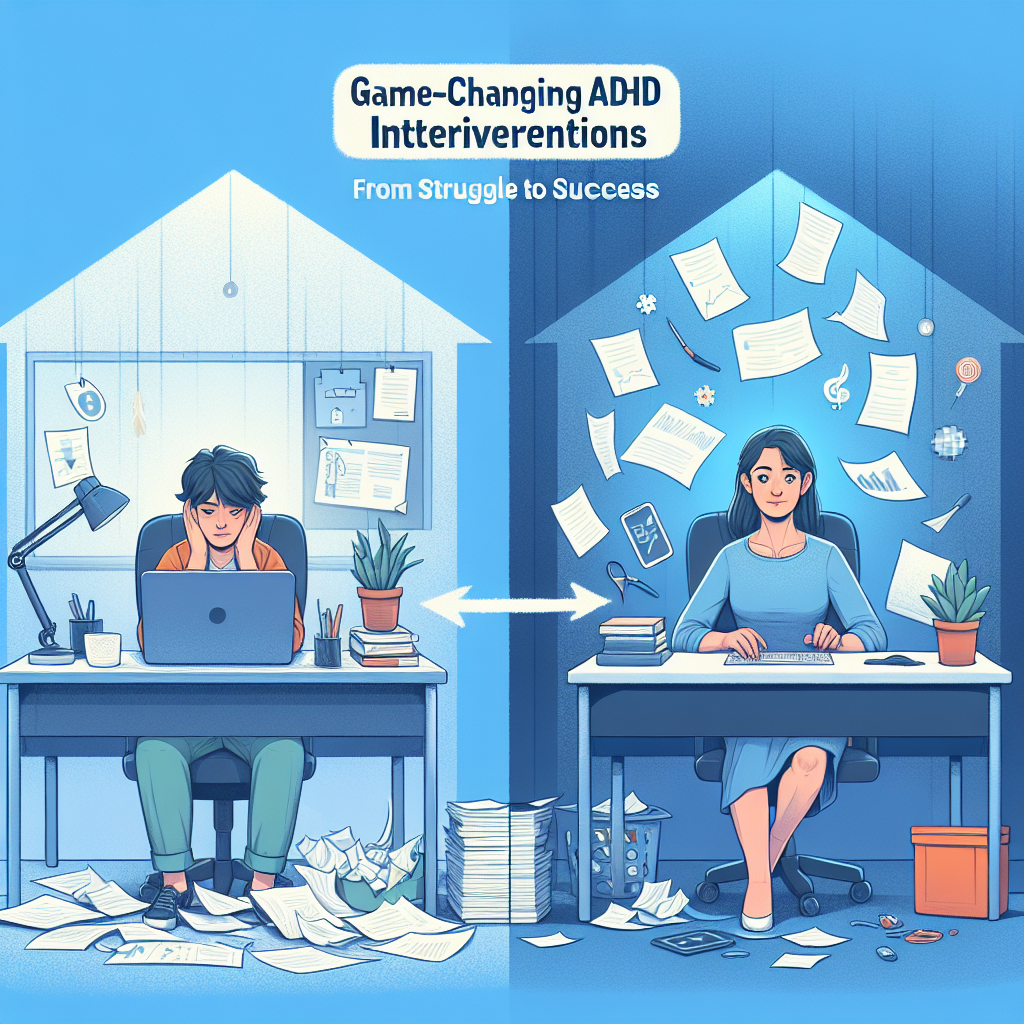
Game-Changing ADHD Interventions: From Struggle to Success
Introduction
Welcome to the exhilarating, roller-coaster world of ADHD! If you’re here, chances are you’re either living with ADHD or know someone who is. And let’s be honest, adulting with ADHD can sometimes feel like trying to juggle flaming swords while riding a unicycle. Sound familiar? You’re not alone. But don’t worry, there are game-changing ADHD interventions that can help transform your daily struggles into success stories.
ADHD, or Attention Deficit Hyperactivity Disorder, isn’t just a childhood condition. Many adults find themselves navigating the challenges of focus, hyperactivity, and impulsivity well into their grown-up years. In fact, boys are diagnosed with ADHD almost twice as often as girls (CDC), and many carry these symptoms into adulthood.
Why Interventions Matter
- Cognitive Behavioral Therapy for ADHD: A powerful tool for changing negative thought patterns.
- ADHD Coaching: Personalized strategies to enhance daily functioning.
- Lifestyle Changes: Simple tweaks in your routine to accommodate your unique brain wiring.
Tackling ADHD isn’t about ‘fixing’ yourself—it’s about equipping yourself with effective tools and strategies. Whether it’s structuring tasks through time management strategies or employing relaxation methods that soothe anxious minds—ADHD doesn’t have to mean confusion or chaos.
This blog will explore various interventions—some traditional, some innovative—and offer insights on how they can turn the tide from struggle towards success in your quest for a balanced life. Ready to dive in? Let’s get started!
Understanding ADHD: A Brief Overview
Before diving into the realm of ADHD interventions, it’s crucial to understand the fundamentals of this often-misunderstood condition. Attention Deficit Hyperactivity Disorder (ADHD) is a neurodevelopmental disorder that affects both children and adults, manifesting as a persistent pattern of inattention, hyperactivity, and impulsivity. It’s like having a never-ending mental race with a finish line that keeps moving further away!
Did you know that approximately 4.4% of adults in the United States live with ADHD? (source) Despite its prevalence, many people still struggle with understanding how this condition impacts daily life. From gender-specific challenges to unique hurdles in adulting, ADHD can feel like trying to juggle flaming swords while riding a unicycle.
The Core Challenges of ADHD
- Inattention: This isn’t just about being easily distracted by shiny objects (though it sometimes feels that way!). Inattention includes difficulties in sustaining focus on tasks or activities.
- Hyperactivity: Think of this as having an internal motor that’s constantly revving up. It involves excessive fidgeting or an inability to remain seated.
- Impulsivity: Ever find yourself blurting out answers before questions are completed? Impulsivity can lead to rash decisions and speaking out of turn.
A common misconception about ADHD is that it’s simply a childhood disorder. However, around two-thirds of children diagnosed continue to experience symptoms into adulthood (source). And let’s be honest—adulting is hard enough without feeling like you’re constantly chasing your own tail!
The Broader Impact on Life
The impact of ADHD extends beyond personal life, affecting professional endeavors and social interactions. Many adults with ADHD experience challenges with executive functions like planning and organizing—a bit like trying to manage an orchestra while only ever having played the tambourine!
- Workplace Challenges: Struggles with prioritizing tasks and meeting deadlines can hinder job performance.
- Social Interactions: Difficulty in maintaining conversations and remembering social cues might cause misunderstandings.
- Mental Health Concerns: There is often an overlap with anxiety or depression, which can intensify the daily struggles faced by those living with ADHD.
If you’re starting to recognize some aspects of yourself in these descriptions or if you’re just curious about how therapy might help manage these challenges, feel free to explore how professional intervention can assist by visiting our resource on emotional control through therapy.
Medication for ADHD: A Tried and True Approach
When it comes to ADHD interventions, medication often takes center stage as a well-researched and effective option. As much as we might sometimes wish for a magic wand to help us focus on that grocery list or finally remember our partner’s birthday without Facebook telling us, medication for ADHD is the closest thing we have to magic beans—minus the fairytale side effects.
Understanding How Medication Works
ADHD medications primarily consist of stimulants like methylphenidate and amphetamines, which might sound counterintuitive at first—after all, why give someone with hyperactivity stimulants? But here’s the twist: these medications actually help increase dopamine levels in the brain, which boosts attention and reduces impulsivity. Think of it as adding a bit of oil to a rusty bike chain; everything just runs smoother.
- Methylphenidate: Commonly known by brand names like Ritalin or Concerta, methylphenidate acts quickly and can significantly improve focus and behavior.
- Amphetamines: Medications such as Adderall fall into this category and are known for their longer-lasting effects.
- Non-stimulants: Options like atomoxetine might be preferred for those who don’t respond well to stimulants or have a history of substance abuse.
The beauty of these medications is that they cater not just to children but are also highly effective in adults. In fact, according to the National Institute of Mental Health, about 70-80% of children with ADHD show improvement when using stimulant medication. This success rate carries over into adulthood, providing many with newfound control over their daily lives—a key component discussed in our extensive resource on adult ADHD therapy.
Finding the Right Fit
No two individuals with ADHD are alike (unless you’ve cloned yourself—in which case, hats off!). It’s essential to work closely with your healthcare provider to tailor an ADHD treatment plan that fits your unique needs. Factors such as potential side effects, medical history, and even lifestyle preferences should be part of this conversation.
If you’re considering starting medication or adjusting your current regimen, it’s always wise to consult professionals who understand your personal journey. Our team at Therapy for Adulting is here to offer guidance every step of the way. You can find more about how specialized therapy can aid your progress by checking out our page on online ADHD therapy options.
Navigating life with ADHD is indeed an adventure—but one need not face it alone. With effective treatment options like medication paving the path from struggle to success, there’s hope and help available at every turn.
Cognitive Behavioral Therapy for ADHD
When it comes to ADHD interventions, Cognitive Behavioral Therapy (CBT) emerges as a shining star, offering hope and direction for adults swimming through the seas of distractions and overactive thoughts. While CBT is often associated with anxiety and depression, it’s also incredibly effective in managing ADHD symptoms. This therapy deals with the cognitive side of things—essentially rewiring your thought patterns to improve focus, organization, and self-control.
What Makes CBT a Game-Changer?
- Practical Skills: CBT equips you with practical skills to deal with everyday challenges, providing strategies to combat forgetfulness or procrastination.
- Goal-Oriented: It’s all about setting achievable goals that gradually build your executive function muscles.
- Flexible Approach: Whether you’re struggling at work or in your personal life, CBT can be tailored to fit your unique experiences.
A fascinating study by Ramsay and Rostain found that adults who received CBT alongside medication experienced marked improvements compared to those who only took medication. These individuals showed enhanced time management skills and were better equipped at planning tasks, which are often monumental feats for someone living with ADHD.
The Connection Between Thoughts and Behavior
If you’ve ever wondered why certain situations seem to derail your day more than others, CBT helps you uncover these mental roadblocks. It focuses on the connection between thoughts, emotions, and behaviors. Imagine this: every time you lose your keys (again), instead of spiraling into a panic (because who hasn’t been there?), you learn to pause. You recognize the thought pattern before it spirals out of control.
The Journey Through Therapy
Let’s take Jane’s story as an example—she’s an adult juggling work projects, a buzzing social life, and her newfound passion for pottery (because why not?). She noticed how often she’d get overwhelmed by seemingly simple tasks. By integrating CBT into her routine, she developed coping mechanisms that helped her manage stress effectively while honing her focus on detailed tasks like glazing that perfect ceramic mug.
Explore how ADHD therapy can help manage emotional regulation here!
If you’re curious about exploring this therapeutic avenue, consider reaching out to a professional who offers online ADHD therapy. Together, you can create personalized strategies geared toward turning those mental hurdles into stepping stones for success! Plus, no more frantic searches for misplaced items—well, maybe just fewer of them!
Mindfulness Techniques: Finding Calm Amidst Chaos
In the whirlwind world of adulting, where managing your to-do list can sometimes feel like taming a wild beast, mindfulness techniques can be your knight in shining armor. For those navigating life with ADHD, finding moments of calm amidst chaos is crucial. Let’s dive into how mindfulness can turn the seemingly impossible into totally manageable.
The Power of Presence
Mindfulness is all about being present in the moment—an art that can sometimes feel like finding a unicorn for someone with ADHD. But hey, unicorns might exist, right? Just like them, practicing presence isn’t as mythical as it seems.
- Breathe Deeply: Try a simple breathing exercise. Inhale deeply for four counts, hold for four, and exhale for four. Repeat until you feel less like a stress ball and more like a Zen master.
- Body Scan: Acknowledge each part of your body as you mentally travel from head to toe. This technique helps ground you and brings awareness to areas that might be holding tension.
- Gratitude Journaling: Take five minutes each day to jot down three things you’re grateful for. It shifts your focus from chaos to appreciation, which is way more fun!
The Science Behind Mindfulness and ADHD
You might be wondering how something as simple as breathing can combat the intricate challenges of ADHD. According to research by NIMH, medication is commonly used for treatment, but incorporating mindfulness strategies has shown promise in improving focus and reducing impulsivity.
In fact, studies have found that regular mindfulness practice can lead to improved emotional regulation and executive functioning—a win-win for anyone battling the daily chaos of ADHD.
Find Your Groove
If you’re new to mindfulness or need a little extra guidance in making these techniques work for you, consider exploring our resources like improving memory with ADHD therapy. Remember, it’s all about finding what suits your unique rhythm!
So next time life feels overwhelming or your brain decides it wants a solo dance party instead of focusing on work, remember: going from struggle to success with ADHD interventions is just a mindful moment away!
ADHD Coaching: Personalized Guidance for Success
Ever felt like you’re navigating a maze with no map? That’s ADHD in a nutshell. But what if you had a coach, someone who can help turn that chaotic labyrinth into a well-organized journey? Enter ADHD coaching, your personal guide to success!
Unlike traditional therapy, ADHD coaching focuses on practical, day-to-day strategies designed to help you manage your symptoms and achieve your personal goals. It’s like having a GPS for your brain—except this one doesn’t keep recalculating every time you take an unexpected detour.
What Does ADHD Coaching Entail?
- Goal Setting: Coaches work with you to set realistic and attainable personal and professional goals.
- Skill Development: Learn essential life skills such as time management, organization, and planning.
- Accountability: Regular check-ins ensure you’re staying on track, offering the gentle (or not-so-gentle) nudges you need.
- Coping Strategies: Develop personalized strategies to manage stress and emotional regulation.
- Adaptive Learning Techniques: Tailored learning strategies that cater specifically to how you process information.
The benefits of ADHD coaching are especially profound when combined with other interventions like behavioral therapy, medication, or lifestyle changes. This holistic approach provides the well-rounded support necessary for thriving in adulthood.
The Power of Personalized Support
A study published in the journal “The Professional Counselor” found that individuals who engaged in ADHD coaching reported significant improvements in self-esteem, goal attainment, and overall satisfaction with life. It’s proof positive that personalized guidance can be transformative (The Professional Counselor). After all, even professional athletes have coaches—so why shouldn’t you?
If you’ve ever felt isolated in your struggles or overwhelmed by life’s daily demands because of ADHD, know that you’re far from alone. Harnessing the power of personalized coaching could be just the game-changer you need to transform struggle into success. Ready to explore more ways ADHD therapy can revolutionize your life? Check out our comprehensive resources on how ADHD therapy can enhance memory and focus.
Lifestyle Changes: Small Adjustments with Big Impacts
Let’s face it, adulting is hard enough without ADHD throwing curveballs your way. But here’s the silver lining: some small lifestyle changes can lead to game-changing shifts in managing ADHD. Think of these as tiny tweaks that can make a world of difference in your day-to-day life.
Prioritize Sleep Like It’s Your Job
Sleep isn’t just a luxury; it’s a necessity. For adults with ADHD, irregular sleep patterns can wreak havoc on concentration, mood, and overall well-being. Set a bedtime routine that rivals that of a toddler’s—minus the bedtime story (unless that’s your jam!). Aim for 7-9 hours of quality shut-eye to help keep those ADHD symptoms in check.
Exercise: The Unsung Hero
You don’t have to become a gym rat, but regular physical activity is crucial. Exercise releases endorphins which boost mood and improve focus. Whether it’s dancing like nobody’s watching or going for a brisk walk, find what moves you—literally.
- The Morning Jolt: A quick morning workout can set the tone for a productive day.
- Team Sports: Join a local league for some social interaction and physical activity rolled into one!
Mindful Eating: Fueling Your Brain
Your dietary choices can be an ally or adversary in managing ADHD symptoms. Foods rich in protein and omega-3 fatty acids are known to support brain health. So next time you need an energy boost, skip the sugary snacks and opt for nuts or fish instead.
- Hydration: Keep that water bottle handy! Dehydration can exacerbate focus issues.
- Avoid Over-Caffeinating: While caffeine helps some folks focus, too much may make things worse.
Cultivate Mindfulness Practices
Meditation might sound daunting but starting small with just five minutes a day can enhance attention and emotional regulation. Apps like Headspace or Calm can offer guided sessions if you’re unsure where to begin.
If navigating life’s challenges with ADHD feels overwhelming, know that you’re not alone. According to Psychiatry.org, ADHD affects various aspects of life from work to relationships across one’s lifespan. You might find solace in knowing others share similar paths and experiences.
If you’re eager to explore more strategies tailored to adults navigating the complexities of living with ADHD, consider checking out this resource on improving memory with ADHD therapy for adults. It could be exactly what you need to curb those forgetful moments!
Technological Aids: Leveraging Tools for Better Management
In this digital age, technology isn’t just a luxury—it’s a game changer, especially when it comes to ADHD interventions. From apps to assistive gadgets, these tools can transform the way adults manage their ADHD symptoms and improve their quality of life.
The App-venture
- Focus Boosters: Apps like Focus Booster use the Pomodoro technique to help break tasks into manageable chunks. This is perfect for those of us who find our attention waning faster than a Wi-Fi connection during a storm.
- Mind Mapping Magic: Tools such as MindMeister can aid in visualizing thoughts and structuring ideas, making it easier to plan projects without feeling overwhelmed.
- Time Management Titans: Apps like Todoist help you prioritize tasks and stay on top of deadlines—ideal for anyone who has ever forgotten about that one important meeting until the day after.
The Smart Assistant Advantage
If your smartphone is basically an extension of your hand, you might as well put it to good use. Virtual assistants like Siri or Alexa can set reminders, manage calendars, and even provide motivational quotes when you’re having a tough day—because nothing says “I’ve got this” like a robot pep talk. These digital helpers are not just gadgets; they’re part of your ADHD management crew.
The Gadget Guide
Apart from apps, other technological aids like noise-cancelling headphones can help reduce sensory overload, significantly benefiting those with ADHD who struggle with noisy environments. Devices that offer haptic feedback can also serve as physical reminders for task management. For instance, smartwatches vibrating at set intervals can nudge you back on track if you’ve wandered off into another realm (or YouTube rabbit hole).
This digital toolkit is far from exhaustive but offers a glimpse into how technology aids in managing ADHD effectively. Whether it’s through planning your day or reducing distractions, these tools offer significant support. And while no app or gadget will wholly replace personalized therapy (check out how ADHD therapy for adults can complement these tools), they certainly push the needle towards success in everyday adulting.
Remember, it’s all about finding what works best for you in this tech-savvy world where innovation meets need—where an app download could be your first step from struggle to success!
Peer Support Networks: Community as a Source of Strength
Living with ADHD can sometimes feel like you’re playing a high-stakes game of pinball, where your thoughts and emotions are the silver balls bouncing off bumpers and flippers at breakneck speed. It’s easy to get overwhelmed and feel isolated in this whirlwind, but you might be surprised by how much strength and support can be found in community-driven ADHD interventions.
The Power of Connection
Engaging with peer support networks offers a lifeline to many individuals navigating the daily challenges of ADHD. These communities provide a safe space where people can share their experiences, learn new strategies, and find understanding from others who truly “get it.” According to CHADD (Children and Adults with Attention-Deficit/Hyperactivity Disorder), these networks play a crucial role in reducing feelings of isolation while fostering resilience through shared experiences.
- Shared Learning: Peer groups allow members to exchange effective coping mechanisms for ADHD, whether it’s time management tips or mindfulness techniques to enhance focus.
- Emotional Support: Talking with those who face similar struggles can help reduce anxiety and bolster emotional well-being. It’s like having your own cheerleading squad who cheers even when you’ve misplaced your phone for the umpteenth time.
- Encouragement: Witnessing peers overcome hurdles can inspire individuals to persevere in their own journey towards success and self-regulation.
Finding Your Tribe
If you’re ready to tap into the power of community, there are numerous ways to connect with supportive peers:
- Online Communities: Websites like ADDitude Magazine offer forums where adults can discuss ADHD management strategies and share personal stories.
- Local Meetups: Check platforms such as Meetup.com for local support groups that focus on ADHD interventions or related topics.
- Social Media Groups: Facebook hosts various groups dedicated to providing ADHD support—just remember, scrolling mindlessly doesn’t count!
The beauty of peer support networks is that they remind us we are not alone in our journey. Together, we can transform struggles into successes by leaning on each other—because sometimes, all it takes is knowing someone else has been there too.
Conclusion: Crafting Your Path to Success with ADHD Interventions
Embarking on the journey of ADHD management is akin to navigating a ship through uncharted waters. But, fear not! With the right map and tools in your arsenal, you can transform those tumultuous waves into a thrilling adventure. Let’s wrap things up by rounding out the game-changing ADHD interventions that can help shape your path to success:
- Behavioral Therapy for ADHD: Getting to grips with behaviors that can sabotage your day is key. Behavioral therapy provides structured interventions to reinforce positive habits while breaking down unhelpful patterns.
- Medication for ADHD: While not everyone’s cup of tea, medications like stimulants have shown significant benefits in managing symptoms effectively. Always consult with a healthcare provider for personalized advice.
- Cognitive Behavioral Therapy (CBT): This form of therapy works wonders in changing thought patterns, offering practical solutions for daily challenges. It’s all about reframing thoughts from “I can’t” to “Watch me!”
- Mindfulness Techniques: Studies have shown that mindfulness can enhance focus and reduce impulsivity – perfect for reigning in that wandering mind (and perhaps finally finishing that book).
- Executive Function Interventions: Goodbye chaos, hello organization! Executive function interventions can help you manage tasks and maintain order in your life like a pro.
If you’re feeling overwhelmed by the plethora of strategies available, remember: it’s okay to start small. Pick one or two interventions and gradually build upon them as they become part of your routine. The aim isn’t perfection; it’s progress.
You don’t have to embark on this journey alone. Whether it’s seeking guidance from an online therapist, joining a support group, or tapping into community resources, there are numerous avenues of support waiting to embrace you.
The road ahead might be dotted with challenges, but embracing these ADHD interventions will light up the path towards greater self-awareness and personal success. Remember, every step forward is a victory worth celebrating!
For more strategies on managing ADHD and improving your everyday life, explore our resources at Therapy for Adulting.


